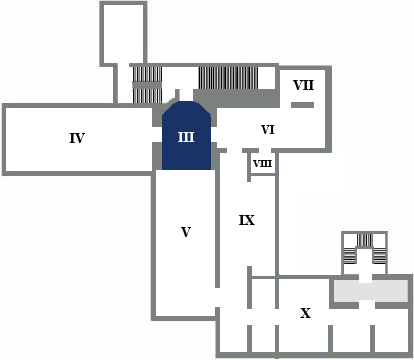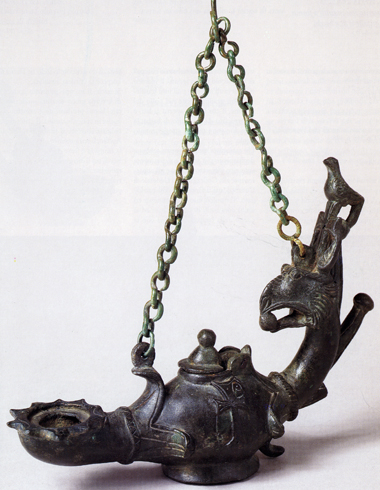
In Room III, the restructured 19th-century attic of the church directly over the apse, a small antiquarium has been laid out; here pre-classical and classical sculptures, archaeological bronze and earthenware objects are on display.
|
|
Greek/Cypriot art
Head of a man
last quarter of 5th century B.C.
The head of a man in yellow limestone which is datable to around 440 B.C. comes from Cyprus, a rich production centre for sculptures to decorate the numerous sanctuaries of the island. The features of the face are quite detailed; the head is swathed in a oak-leaf crown which intermingles with the locks, the eyelids are carved with tiny herringbone strokes, the eyes are large, the eyelids in relief, the moustache flows down the sides of the narrow lips, the beard is thick. This is the portrait of the ideal worshipper, gratifying the vanity of the deity with his presence and eternal smile.

|
|
Rome
Oil-lamp with griffin's head handle
4th-5th century A.D.
The bronze oil-lamp, made around the 4th century A.D., comes from the first artefacts of the Christian age. The body is boat-shaped, symbolising the Church. The curved handle shows the head and neck of a griffin surmounted by a dove, animals recalling the unending battle between good and evil.

|
|
Rome
Head of Apollo, Lyceum style
The head portraying Apollo is a fragment of a full-figure sculpture made in Rome as a replica of a Greek prototype which was very popular and widespread. Lyceum Apollo, shown in a moment of repose and reverie, has his right arm folded over his reclined head. A plectrum for the lyre can perhaps be identified in the mutilated hand; this indicates that the statue was designed to portray Apollo with his harp and not in its original iconographical form with a bow in one hand.
|
|